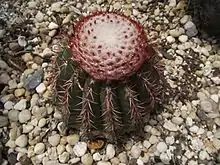| Melocactus conoideus | |
|---|---|
 | |
| Scientific classification | |
| Kingdom: | Plantae |
| Clade: | Tracheophytes |
| Clade: | Angiosperms |
| Clade: | Eudicots |
| Order: | Caryophyllales |
| Family: | Cactaceae |
| Subfamily: | Cactoideae |
| Genus: | Melocactus |
| Species: | M. conoideus |
| Binomial name | |
| Melocactus conoideus Buining & Brederoo | |
Melocactus conoideus is a species of plant in the family Cactaceae. It is endemic to Brazil. Its natural habitat is dry savanna. It is threatened by habitat loss. It is a species of cacti that originates in Vitória da Conquista, located in the southwestern portion of the state of Bahia, Brazil. This species of cactus was discovered by the German émigré Leopold Horst. This species spreads by bearing fruit with seeds that ants take and transport to other locations that it can grow.
References
- ↑ Machado, M.; Taylor, N.P.; Braun, P.; Zappi, D. (2013). "Melocactus conoideus". IUCN Red List of Threatened Species. 2013: e.T40914A2943248. doi:10.2305/IUCN.UK.2013-1.RLTS.T40914A2943248.en. Retrieved 17 November 2021.
- ↑ Luz-Freire, H. P., Trindade, D. P. F. da, Sá-Neto, R. J. de, & Corrêa, M. M. (2014). Survival dynamics of Melocactus conoideus Buining & Brederoo (Cactaceae), a threatened species endemic to northeastern Brazil. Acta Botânica Brasilica, 28(2), 293–297. https://doi.org/10.1590/S0102-33062014000200016
- ↑ Katielle Silva Brito-Kateivas. (2012). Ants interacting with fruits of Melocactus conoideus Buining & Brederoo (Cactaceae) in southwestern Bahia, Brazil. Biotemas, 25(3), 153–159. https://doi.org/10.5007/2175-7925.2012v25n3p153
- ↑ Taylor, N. P. (1992). PLANTS IN PERIL, 17 MELOCACTUS CONOIDEUS. Curtis’s Botanical Magazine (1995), 9(3), 138–141. https://doi.org/10.1111/j.1467-8748.1992.tb00086.x
- ↑ "Appendices | CITES". cites.org. Retrieved 2022-01-14.
This article is issued from Wikipedia. The text is licensed under Creative Commons - Attribution - Sharealike. Additional terms may apply for the media files.
